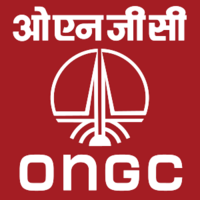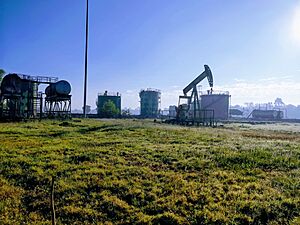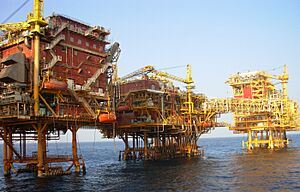Oil and Natural Gas Corporation facts for kids
 |
|
| Public | |
| Traded as | |
| ISIN | [https://isin.toolforge.org/?language=en&isin=INE213A01029 INE213A01029] |
| Industry | Energy: Oil and gas |
| Founded | 14 August 1956 |
| Headquarters | Deendayal Urja Bhawan, 5A-5B Nelson Mandela Road, Vasant Kunj, Delhi,
India
|
|
Area served
|
Worldwide |
|
Key people
|
Arun Kumar Singh (Chairman & CEO) |
| Products | |
| Revenue | |
|
Operating income
|
|
| Total assets | |
| Total equity | |
| Owner | 58.89% Government of India |
|
Number of employees
|
25,847 (including 10,094 workers) (March 2024) |
| Divisions |
|
| Subsidiaries |
|
The Oil and Natural Gas Corporation Limited (ONGC) is a big Indian company. It is owned by the government. ONGC is the largest company in India that explores for and produces oil and natural gas.
It creates about 70% of India's crude oil and 84% of its natural gas. ONGC's main office is in Delhi. The Government of India owns and manages this company. It started on August 14, 1956. In 2010, the government gave ONGC the special "Maharatna" status. This means it is a very important and successful public sector company.
In 2019–2020, ONGC was the most profitable government company in India. It is also ranked among the top global energy companies.
ONGC is involved in all parts of the oil and gas business. It looks for oil and gas in 26 areas across India. The company also runs over 11,000 kilometers of pipelines. It uses about 230 drilling machines. Its international branch, ONGC Videsh, works in 15 countries. ONGC has found most of India's oil and gas fields. It has discovered over 7.15 billion tons of oil and gas. Even from older fields, ONGC keeps producing oil. It does this by investing in new ways to get more oil out.
History of ONGC
How ONGC Started
Before India became independent in 1947, only two companies produced oil. These were the Assam Oil Company and the Attock Oil Company. They did not do much exploration. Most of India's land was thought to have no oil or gas.
After India became independent, the government saw how important oil and gas were. They were needed for fast industrial growth and for defense. So, in 1948, the government decided to develop the oil industry.
Until 1955, private companies mainly looked for oil. The Assam Oil Company produced oil at Digboi. Oil India Ltd. found new fields in Assam. Another company, Indo-Stanvac Petroleum, explored in West Bengal. But large parts of India remained unexplored.
In 1955, the Indian government decided to develop oil and gas resources itself. They created the Oil and Natural Gas Directorate. This office was part of the Ministry of Natural Resources. It started with geoscientists from the Geological Survey of India.
Indian officials visited European countries to learn about the oil industry. They also arranged training for Indian experts. Experts from Romania, the Soviet Union, the United States, and West Germany visited India. They helped the government with their knowledge. Soviet experts then made a plan for surveys and drilling. This plan was for India's second Five Year Plan (1956–61).
In April 1956, the government made a new policy. It said that the oil industry would be fully controlled by the state.
Soon, the Directorate needed more power to work well. So, in August 1956, it became a commission. This gave it more financial and administrative power. In October 1959, the commission became a legal body. This meant it had even more power. Its main job was to plan and carry out programs. These programs were for finding and producing oil and gas. It also sold the oil and gas it produced.
Growth and Discoveries
Since it started, ONGC has greatly changed India's oil and gas sector. It has grown its activities across India and in other countries. In India, ONGC found new oil in Assam. It also found a new oil area in Gujarat. New oil-rich areas were also found in other parts of India.
In 1963, ONGC found oil and gas in Sivasagar district. It set up oilfields in Lakua, Gelekey, and Rudrasagar.
In the early 1970s, ONGC started looking for oil offshore. It found a huge oil field called Mumbai High. This discovery, and others in the Western offshore, changed India's oil situation. Over 5 billion tons of hydrocarbons were found in India. ONGC's most important contribution is its ability to work independently. It has become very good at finding and producing oil and gas.
In February 1994, ONGC became a public company. 20% of its shares were sold to the public. The Indian government kept 80%. At that time, ONGC had 48,000 employees. It had a lot of money saved up. Its total value was the largest of any Indian company.
In 1958, the chairman, Keshav Dev Malaviya, decided ONGC should look for oil outside India. This was to increase India's own oil production. Experts believed India's oil demand would grow faster than new discoveries.
Malaviya helped ONGC apply for exploration licenses in the Persian Gulf. Iran gave ONGC four areas. Malaviya asked other companies to join ONGC in Iran. This led to the discovery of the Rostum oilfield in the 1960s. This was India's first investment in oil production in other countries. Oil from Rostum was brought to India to be refined.
Recent Developments
In 2003, ONGC Videsh Limited (OVL) bought a share in the Greater Nile Oil project. OVL is ONGC's international branch.
In 2006, special coins were made to celebrate ONGC's 50th anniversary. ONGC was only the second Indian company to have such coins.
In 2011, ONGC wanted to buy land in Dahanu. This land was for processing gas from offshore. In 2012, ONGC Videsh worked with companies from Norway and Spain. They drilled for oil deep underwater off the coast of Cuba. On August 11, 2012, ONGC announced a big oil discovery. This was in the D1 oilfield off India's west coast. This discovery helped increase the field's output.
In January 2014, OVL and Oil India bought a share in a gas field in Mozambique. This deal was worth $2.47 billion.
In June 2015, ONGC gave a large contract to Larsen & Toubro (L&T). This was for the Bassein development project.
In February 2016, ONGC decided to invest a lot of money in Tripura. This was for drilling wells and building facilities. The goal was to produce 5.1 million standard cubic feet of gas per day.
On July 19, 2017, the Indian government approved ONGC buying Hindustan Petroleum Corporation.
Reports showed that ONGC's oil production decreased from 2018 to 2023. Despite this, in 2023, ONGC announced plans to invest a lot of money. This investment is for exploring deepwater areas.
In May 2023, ONGC said it would start oil production in the Krishna Godavari Basin by June. It also appointed Manish Patil as its human resources director.
How ONGC Works
ONGC explores for and produces oil and gas. It also refines oil and develops new energy sources. These new sources include coal-bed methane and shale gas. The company's work in India is organized into 11 main areas. These areas mostly produce oil and gas. There are also 7 exploration areas. ONGC has 2 plants, one at Hazira and one at Uran. It also has services for drilling and other support.
ONGC's Subsidiary Companies
ONGC has several important subsidiary companies. These companies help ONGC with its different operations.
ONGC Videsh Limited (OVL)
ONGC Videsh Limited (OVL) is ONGC's international branch. It was renamed in 1989. OVL's main job is to find and produce oil and gas outside India. It currently has 38 projects in 17 countries. Its oil and gas production grew a lot from 2002 to 2010. ONGC owns 100% of ONGC Videsh Limited.
OVL works in many parts of the world:
- Latin America: Brazil, Colombia, Cuba, and Venezuela.
- CIS & Far-East: Vietnam, Myanmar, Russia, and Kazakhstan.
- Africa: Libya, Mozambique, Nigeria, and South Sudan.
- Middle East: Iran, Iraq, Syria, and UAE.
Hindustan Petroleum Corporation Limited (HPCL)
Hindustan Petroleum Corporation Limited (HPCL) is an Indian oil and natural gas company. Its main office is in Mumbai. It has about 25% of the market share in India among government companies. It also has a strong marketing network. Oil and Natural Gas Corporation owns 51.11% of HPCL's shares. The rest are owned by other groups and people. HPCL was ranked 367th among the world's biggest companies in 2016.
Mangalore Refinery and Petrochemicals Limited (MRPL)
Mangalore Refinery and Petrochemicals Limited (MRPL) is an oil refinery in Mangalore. It can process 15 million metric tons of oil each year. It produces premium diesel and high-octane unleaded petrol.
ONGC Mangalore Petrochemicals Limited (OMPL)
ONGC Mangalore Petrochemicals Limited (OMPL) is a company started by ONGC and MRPL. ONGC owns 49% of the company, and MRPL owns 51%. OMPL is a subsidiary of MRPL. It was started on December 19, 2006. The OMPL complex is very large, covering 442 acres. It is connected to the MRPL Refinery, which supplies it with materials. The complex is close to the New Mangalore Port and Mangalore International Airport.
Joint Ventures
ONGC also works with other companies in joint ventures.
ONGC Tripura Power Company (OTPC)
ONGC Tripura Power Company (OTPC) is a joint venture. It was formed in September 2008. The partners are ONGC, Infrastructure Leasing and Financial Services Limited, and the government of Tripura. OTPC built a large power plant in Palatana, Tripura. This plant produces 726.6 MW of electricity. It supplies power to areas in northeastern India that need it.
ONGC Petro Additions Limited (OPaL)
ONGC Petro Additions Limited (OPaL) is a large joint venture company. It was started in 2006. ONGC, Gas Authority of India Limited (GAIL), and Gujarat State Petroleum Corporation (GSPC) promoted it. ONGC owns 49.36% of OPaL's shares. GAIL owns 49.21%, and GSPC holds the rest.
OPaL's complex in Dahej, Gujarat, started operating in March 2017. The Prime Minister of India, Narendra Modi, opened it. The complex covers 585 hectares. Construction began in 2008. This project cost about ₹30,000 crore (equivalent to ₹420 billion or US$7.2 billion in 2023) crore. It is part of India's first special region for petroleum and chemicals.
As of 2023, the complex can produce 1.5 million tons of polymers each year. It also makes 0.5 million tons of other petrochemical products.
Training Institutes
- Institute of Petroleum Safety, Health and Environment Management, Goa
Products and Services
ONGC provides crude oil, natural gas, and other valuable products. It supplies these to major Indian oil and gas companies. Its main products are crude oil and natural gas for the Indian market.
ONGC's shares are traded on the Bombay Stock Exchange and the National Stock Exchange of India. It is part of important stock indexes like BSE SENSEX and S&P CNX Nifty.
As of March 31, 2013, the Government of India owned about 69% of ONGC's shares. Over 480,000 individual shareholders owned about 1.65% of its shares. The Life Insurance Corporation of India is the largest non-government shareholder. It owns 7.75% of the shares.
Employees
As of March 31, 2024, ONGC had 25,847 employees. About 7.9% of these employees, or 2,043 people, were women.
Awards and Recognitions
ONGC has received many awards for its work:
- It was named the top employer in the energy sector in India in 2013.
- ONGC won the 'Golden Peacock Award 2014' for its social responsibility. It also won the 'Golden Peacock Award 2013' for safety and health.
- In April 2013, Forbes ranked ONGC 155th among the world's largest listed companies.
- In 2011, Transparency International ranked ONGC 39th globally for transparency in reporting. This made it the most transparent company in India.
- The Government of India gave ONGC the 'Maharatna' status in November 2010. This status gives the company more freedom in making decisions.
- In February 2014, FICCI gave ONGC the Best Company Promoting Sports Award.
- ONGC won the "Greentech Excellence Award" in 2013.
- ONGC has been listed among India's most trusted brands in various reports.
- ONGC was the main sponsor for the first Corporate Social Responsibility (CSR) Award by Amar Ujala.
See also
- ONGC FC
- List of companies of India
- Make in India
- Forbes Global 2000
- Fortune India 500
- Indian Institute of Technology (Indian School of Mines), Dhanbad
- Rajiv Gandhi Institute of Petroleum Technology



